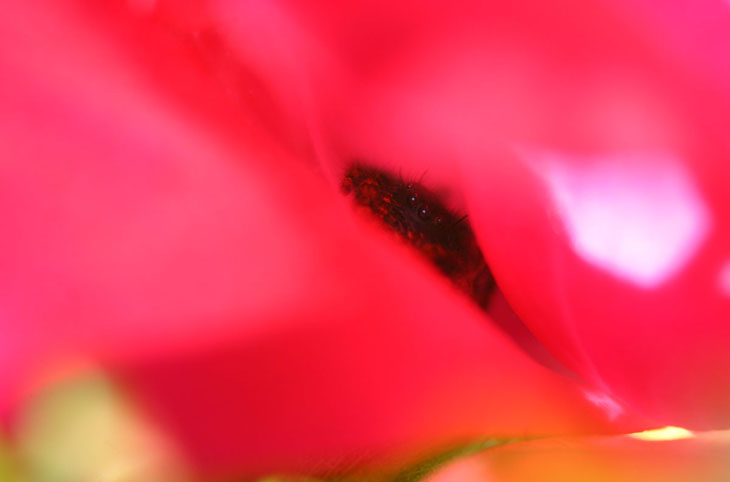
While the weather has produced a few cold snaps and the trees are progressing into their autumn colors, the arthropods have gotten harder to spot, but can yet be found. Above, a jumping spider (genus Phidippus) saw me coming and took refuge in a shelter it had created within a rose blossom, presenting a significant photographic challenge – this is the best I could manage, since only one angle allowed light either in or out, and I had the choice of firing a flash into the crevice or actually allowing the lens a clear field of view. Still, it gives an abstract impression of the conditions for shooting bugs.
On the side of the house I found a very large wheel bug (Arilus cristatus,) a form of assassin bug, so named for that weird projection on the sholders – this one measured about 35mm in length, perhaps the largest I’ve seen and, if the girth was any indication, a female seeking a place for her eggs. I could be wrong – this is the south after all. I collected her and a branch as a setting, rather than work on the side of the house, but made a mistake visible here: I used a photo print as a background, and the pattern of the box turtle (that was the main subject of the print) remains visible to the right. Perhaps not everyone will notice this, but the pattern is distinctive and it jumps right out at me.
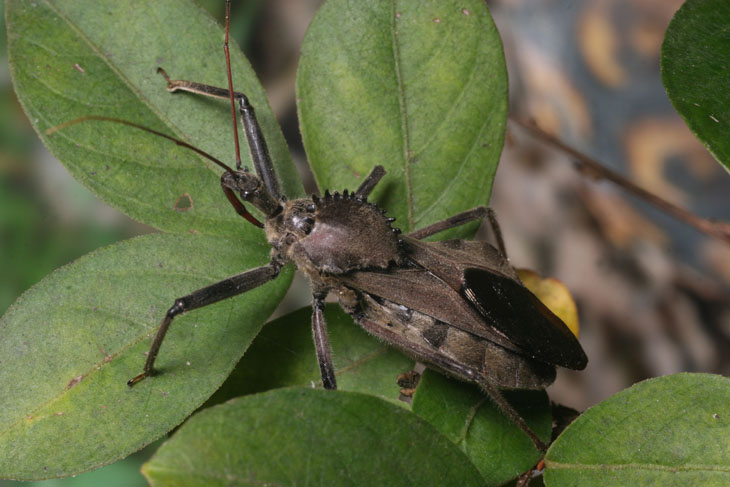
At the same time, I also found a species I’ve never seen before; judging from the legs, wings, and the shape of the head and mouth, I am pegging this as an Orthopteran of some kind, the order that includes grasshoppers, katydids, and crickets. [Note: as I type this, I decided to check BugGuide.net for a further detail, and right smack on the homepage was another example of the species, posted just seventeen minutes ago – it is a narrow-winged tree cricket, Oecanthus niveus. Or, was. But I’m getting ahead of myself.]

I have been working on a couple of school presentations, and the wheel bug was a nice model to do some anatomical detail images from; few insects (around here) get to be this size, so it was a prime opportunity. Also helpful was the sluggish nature of wheel bugs, which tend to be rather dainty in manner – if they don’t fly away first. While this one tended to try and switch to the underside of the leaves, I was still able to go in for some significant closeups, close enough to see the sand grains adhering to its head.
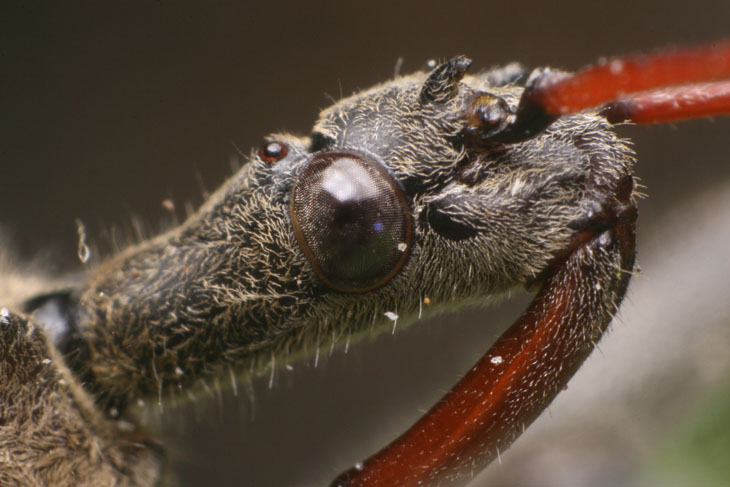
Looking at the eyes, you can see the curious shape of the flat-planel flash rig I use, but also a blue spot; that’s the LED flashlight I use as a focusing aid with the fixed-aperture reversed 28-105, all explained in this post. One of the benefits of working in a macro ‘studio’ indoors is that I can use an AC power source for the flash unit, providing a recharge time of 4-5 seconds and indefinite use, which batteries definitely can not maintain. Plus if my subject tries to fly away (which this one did not,) I can usually recapture it again.
After a productive session with the wheel bug, I dropped the tree cricket onto the same branch without removing the wheel bug. I was mostly after detail pics like the one further up, but I also knew that assassin bugs prey on other insects, and I was curious as to whether my subject might do this as I watched, or if it would be too wary of my presence to engage in such behavior. The tree cricket, in less than a minute, blundered directly into the wheel bug and effectively answered this question for me, since the assassin wasted no time with a potential meal so blithe.
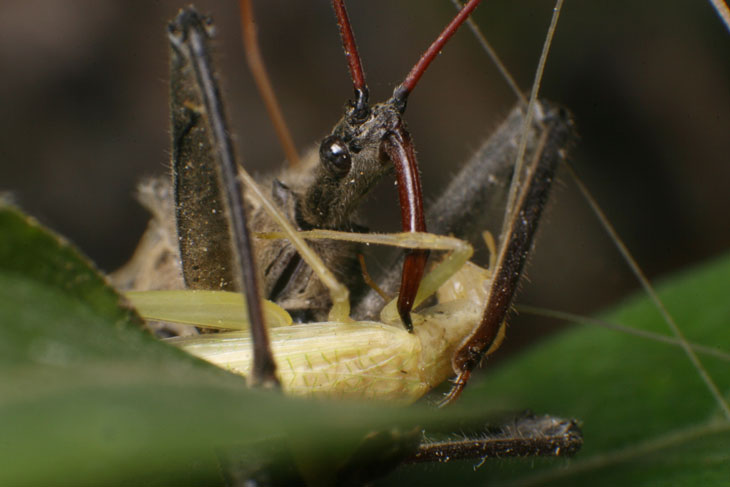
I have been told that the proboscis of an assassin bug, shown so clearly here, can deal a nasty bite to anyone handling one incautiously, though I have yet to experience this for myself, despite having handled an untold number of them – basically, don’t grab them, but scoop them up gently if you have to use your hands at all. Most times, however, I simply nudge them onto an index card or into a film can (ask your parents what that is.)
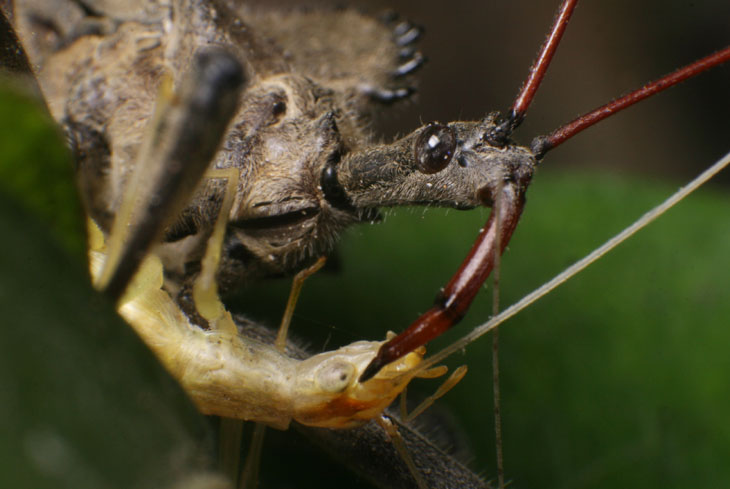
I could not tell from this image whether the wheel bug was actually penetrating the chitin of the tree cricket, or if it was simply waiting for me to move on before it finished its meal, but the position of the cricket’s forelegs reminds me strongly of the classic villain-ingenue poses from pulp novels and movie posters many decades ago. I don’t think I could have planned so dramatic a pose, so yeah, Happy Halloween.
I did eventually leave the wheel bug in peace to finish her meal, but in checking back later on, I found a few strands of web practically over top of the bug, and along some of the other leaves. Apparently, when I had cut the short twig I brought along another resident, a minuscule spider that would appear to be genus Wulfila, perhaps Wulfila albens, a type of sac spider. BugGuide.net’s handy little spider eye chart has been inordinately useful many times over in my search for proper species, though it does require that you have a very clear view of the eyes, which is not always easy to accomplish.
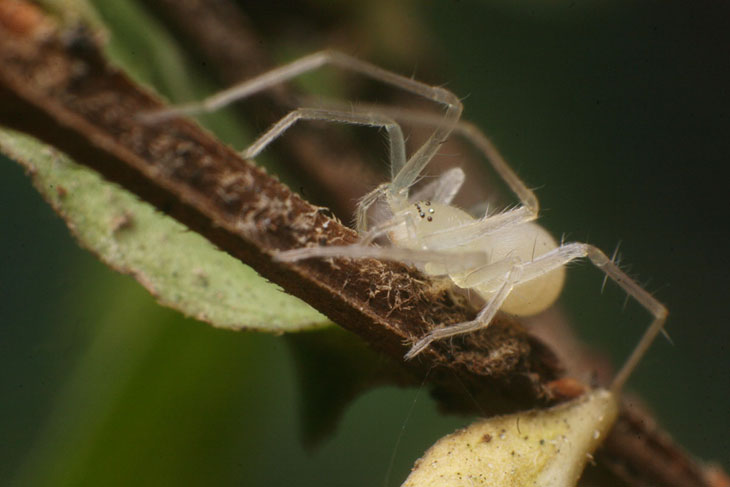
Despite the rather menacing appearance in this image, the spider was tiny, able to sit with legs fully spread on a fingernail without overlapping, and would not have posed a hazard even to the tree cricket. I later released both the spider and the wheel bug, though I would have liked to have seen where, if anyplace, the eggs were eventually laid.
 Looking out the window the other day, I saw the curious spectacle of a harvestman spinning on a bit of pine bark dangling from a stray web strand – this is mildly notable in that harvestmen do not spin webs nor climb them, so I’m not actually sure how this one got there, and it didn’t seem to know what to do itself. Most people I’ve met seem to refer to these by the marvelously technical-sounding name of “daddy longlegs,” though that same nomenclature is applied to species of crane flies as well – “harvestman” is the more appropriate common name, but like all common names, it’s better to go with the scientific names for accuracy. In this case Opiliones is the overall Order, an arachnid but not a spider – and no, they’re not the most venomous arthropod in North America, they have no venom at all. Urban legends are ridiculously hard to get rid of. According to one source I found, it’s not even clear if they hunt or only scavenge, feeding on insects already dead. My own experience hasn’t contradicted the scavenge idea, and in fact I have photographed them carrying long-dead caterpillars. I have also only seen them feeding at night, so that’s the time to look if you’re interested yourself (what am I saying, “if” – of course you are.)
Looking out the window the other day, I saw the curious spectacle of a harvestman spinning on a bit of pine bark dangling from a stray web strand – this is mildly notable in that harvestmen do not spin webs nor climb them, so I’m not actually sure how this one got there, and it didn’t seem to know what to do itself. Most people I’ve met seem to refer to these by the marvelously technical-sounding name of “daddy longlegs,” though that same nomenclature is applied to species of crane flies as well – “harvestman” is the more appropriate common name, but like all common names, it’s better to go with the scientific names for accuracy. In this case Opiliones is the overall Order, an arachnid but not a spider – and no, they’re not the most venomous arthropod in North America, they have no venom at all. Urban legends are ridiculously hard to get rid of. According to one source I found, it’s not even clear if they hunt or only scavenge, feeding on insects already dead. My own experience hasn’t contradicted the scavenge idea, and in fact I have photographed them carrying long-dead caterpillars. I have also only seen them feeding at night, so that’s the time to look if you’re interested yourself (what am I saying, “if” – of course you are.)
I went down to Ederia Pond to collect some water samples, spurred on by the Triops failures to see what kind of native aquatic subjects I could find, which so far hasn’t been much (lots and lots of daphnia.) But with the water sample I collected no small number of floating aquatic plants which I’m not going to bother trying to identify, and with those came along a few riders.
With their coloration and diminutive size (roughly a millimeter in length) they were hard to spot, but the plants were quite laden with aphids, dozens collected within a patch of plants perhaps 7 cm across that came into the jar with the water sample. There’s not a lot to be said about aphids, and less to photograph, really, but while I had them in front of me…

Now, let me correct myself: I know they’re perched on duckweed here, but I choose this image for the clarity, and it does not represent the bulk of the aquatic plants I collected, which you’ll see in the next image – something vaguely fernlike.
Along with the aphids came a weevil of some kind, larger than the largest aphid at a whopping (and confirmed) 1.8mm in length – I just happened to like its appearance. The spherical droplet seen here was actually produced by the weevil, though how and why I cannot say, seeing that it was only visible in the viewfinder because it produced a curious reflection of the light.
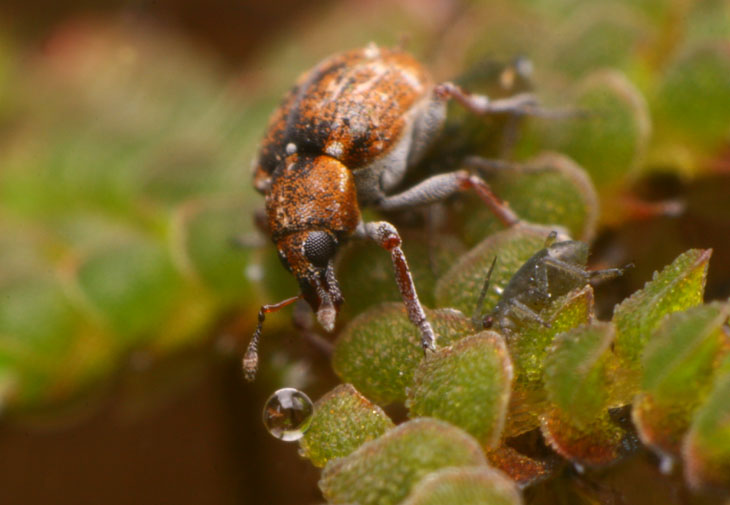
Judging from the variety of images that I obtained, the weevil was milking the aphids for their ‘nectar’ the same way that ants do, but I cannot be absolutely sure of that – all I know is that nearly every image has an aphid very close by or actually under the feet of the weevil. I tried identifying this one, but there are a million varieties and the only identifiers I can use – “orange,” “rust,” “tiny” – haven’t turned up anything. Think hard about this if you want to go into arthropod photography: cataloging the little bastards can be seriously time-consuming.
The slow season for insects is almost nigh, which means you won’t see many posts like this for a while (you’re greatly saddened by that, I can tell.) This does mean I’ll be switching to more landscape, abstract, and fartsy stuff, and in fact, there’s another post largely of that nature in the works…




















































